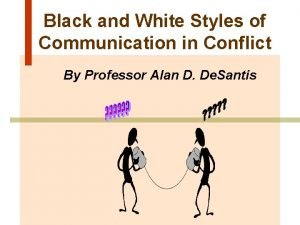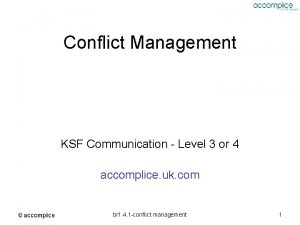Styles and Tactics Conflict Styles are patterned responses










- Slides: 10

Styles and Tactics Conflict Styles: are patterned responses, or clusters of behavior, that people use in conflict. Tactics: are individual moves people make to carry out their general approach. Styles describe the big picture, whereas tactics describe the specific communication moves of the big picture.

Tactics sound planned, but often are not. When you use a tactic numerous times, it becomes a style ( a patterned response).

Avoidance Tactics Denial and equivocation: Denial, or evasive remarks strategic ambiguity “Let’s talk about it sometime, ”or “I’ll be home late. ” “What about my ex? What about Topic management: Topic shifts, or topic avoidance. “Let’s not talk about my past relationship. yours? ” Noncommittal remarks: Statements that neither affirm or deny the presence “I’m not sure ifof. I’mconflict. upset about that. ” “Why do you always want to talk. Friendly about our relationship? Irreverent remarks: joking Who are you Dr. Phil? !”

Personal Criticism: Criticizing personal Destructive Competition Tactics characteristics, or behaviors. “You’re so messy, irresponsible, Statementsetc. ” that reject the Rejection: perspective. partner’s “I feel so strongly that I don’t care what you think. ” Hostile Imperatives, jokes, questions : Demands, threats, teasing sarcasm, leading questions. “I forgot, you’re always right!” Presumptive remarks: Assumptions about your “You’re so predictable, I knew you’d hate it. ” partners thoughts and feelings.

Accommodation Tactics Giving up/giving in: “Have it your way. ” Disengagement: “I don’t really care that much. ” Denial of needs: “It’s OK. I can stay late and work. ” Expression of desire for harmony: “It’s forgotten, don’t worry about it. ”

Compromise Tactics Appeal to Fairness: “You got what you wanted last time. ” Suggest a Trade-off: “I’ll scratch your back, if you scratch mine. ” Quid pro quo Maximize wins/minimize losses: “I’ll give up the idea of going to my folks house for Christmas, if we go to Hawaii together. Offer a quick, short term solution: Let’s do it my way first, and see if you like how it works.

Collaboration Tactics What are Collaboration Tactics? Give an example of each. (from your personal experience, preferably).

Write a dialogue (which can be from your own experiences, or fictional) with six exchanges that use tactics from your assigned style. After you finish, improve it by writing a dialogue that uses collaboration tactics.


In the following movie clip, which tactics are being used? Is there enough repetition that reveals a conflict style?
 Insidan region jh
Insidan region jh Patterned response definition
Patterned response definition Characteristics of properly designed selection tests
Characteristics of properly designed selection tests Common responses to conflict
Common responses to conflict Black and white styles in conflict
Black and white styles in conflict Internal and external conflict worksheet
Internal and external conflict worksheet What is conflict and conflict resolution?
What is conflict and conflict resolution? Internal vs external conflict examples
Internal vs external conflict examples Owl conflict management style
Owl conflict management style Ksf owl
Ksf owl 5 types of conflict
5 types of conflict


















